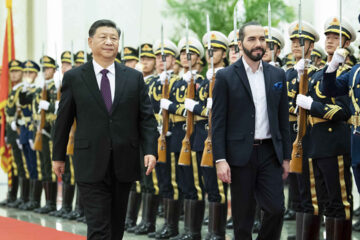
Kyrgyzstan is a country at a crossroads. The Kyrgyz public has thrown out its governments by mass protest twice in the last ten years, and may well to do so again in the near future, with the rise of public disaffection to poorly disguised vote rigging in mayoral elections: a measure to ensure that allies of the president, Atambayev, returned to power.
However, genuine public demand for change, for action on corruption and longer term economic development, is running headfirst into an unpleasant geopolitical reality As China’s economic and political power has grown it has begun reaching out to neighbouring states, searching for influence and investment opportunities. Central Asia has been a priority, given its geographical proximity and lack of Western influence, but this has come into conflict with Russian security interests in its near abroad. The problem, is that both sides use patronage though investment as a means to gain influence with Kyrgyz policymakers, and in the absence of strong, transparent public institutions, this drives massive corruption. Thus, these competing geopolitical and domestic pressures drives Kyrgyz politics through its cycles of revolution and corruption, preventing the stable investment and growth needed to lift Kyrgyzstan out of poverty.
Kyrgyzstan has followed the path of many former Soviet states. Initially a former party big wig, Atayev took power under the auspices of providing a clean break from the Soviet Union. While the statues of Marx and Lenin disappeared from Bishkek’s streets, and the Red Stars disappeared from state buildings and military uniforms, authoritarianism remained strong, and corruption rife. In 2005, public anger reached the crescendo of the Tulip revolution, and a bloodless coup in which Atayev fell from power and fled the country, to be replaced by Bakiyev. Little in reality changed, and in 2010 we saw yet another revolution that brought first Roza Otunbayeva, a renowned protest organiser.
However, the promises of the 2010 revolution have rung empty. Corruption remains endemic, with vote rigging and expropriation of state resources remaining commonplace. Roza’s successor- Atambayev- has fallen back into the corrupt crony policies of his predecessor.
But why, despite a clearly motivated civil society, has this occurred?
Partly, the answer lies in economics. Kyrgyzstan is economically in a very weak position. It remains primarily an agrarian and resource based economy, while lacking significant petrochemical reserves. It has suffered dramatically due to the massive former integration with the Soviet Union and it has struggled to find new trade partners or investors in its economy. In fact, it earns about 30% of its GDP via remittance payments from its neighbouring states.
Politically, this effectively leaves the government open to the highest bidder. Traditionally, this has remained Russia, granting some level of stability post USSR, but this is starting to change.
Economically and militarily, China is rapidly outstripping Russia, and now has the resources and power to start moving into former Soviet East Asia, looking for investment opportunities and allies close to its own borders. It sees Russia’s new distraction with the geopolitical competition with the West as an opportunity to expand its influence in the East. China has exploited this distraction in two ways. Rather than challenging Russia militarily, in a way that could shift Russian attention violently back to its actions, it has invested massively in Kyrgyzstan, recently striking a deal to put in over $3bn in Infrastructure and Resource exploration.
Russia, in turn, has responded with a debt write off of $500m and arms investment of 1.1bn.
This security competition for investment has a horrific effect on Kyrgyzstan’s continuing instability and social woes. Respective governments and government factions play Russia and China off against each other in the hope of maximising the investment that they can extract. However, little of this investment can successfully trickle down to the general population and is expropriated by elites.
Thus, both Russia and China see Kyrgyzstan as a key battleground. Just as with Putin’s policy of Novorussia in the West, using clandestine force to destabilise any chance of a united, pro-Western Ukraine, he follows a similar policy in the East, unwilling to relinquish influence and control from areas that were once part of the Soviet Union. China, in turn, seems likely to slowly turn the pressure up on Russia, out investing it until it is forced to call time on its influential positon.
We may well see a new revolution within Kyrgyzstan, with the public unable to cope with the failure of government to improve their lives in any sort of timely or meaningful way. But in the short term, there does not seem to be a sure-fire way of getting out of this cycle. Another Authoritarian will take power or will be created in power due to the sheer financial resources that Russia and China have to dish out. And as the Ukraine crisis moves inevitably towards some sort of conclusion either way, East Asia is sure to become far more central to Russian security policy, with greater Sino-Russian tension, and thus greater Kyrgyz instability, being the likely result.
By George Greenwood


